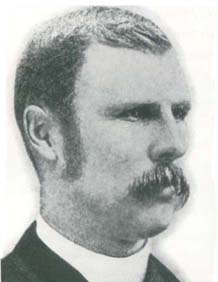George
Chaffey
Father
of Irrigation 1848 -1932
Canada is famous
for the fresh water contained in the lakes and rivers that define great
expanses of its landscape. Some of Canada's most famous scientists, biologists,
geologists, and engineers have received global fame and recognition for
their attempts to control and utilize these water resources. One of these
was George Chaffey, who made his mark, first in Canada, then internationally
in both the United States and Australia.
Born in 1848, George
was the eldest child of George Chaffey and Ann Marie Leggo of Brockville,
Canada West (Ontario). George Chaffey Sr. had established a shipbuilding
operation in Brockville before venturing to Kingston in 1859. The precocious
George Jr. attended the esteemed Kingston Grammar School for only a short
time. His first love, engineering, could not be satisfied in school, therefore,
by the age of 14 he was apprenticed as a marine engineer on Lake Ontario
steamships. George then learned administrative skills in Toronto at the
bank of his Uncle Benjamin Chaffey. There in 1869 he married Annette, the
only daughter of Thomas McCord, the city chamberlain. In the decade of
the 1870s, he formed, with his father, a partnership that specialized in
building shallow-draught steamers for the Great Lakes and Ohio River trade.
 |
William
Chaffey, viewed here in 1886, although identified with his older brother
in developing the San Bernardino Valley in Southern California, is perhaps
better known in South Australia, where today he is looked upon as the father
of irrigation in Australia’s Murray River Valley. [Photo courtesy Ontario
City Library, California/Model Colony Room Collection] |
In 1878, George Sr.
was enticed to join a Canadian settlement in Riverside, California, where
the Santa Ana River irrigation scheme had earlier been established. George
Jr. followed a younger brother, William Benjamin (1856-1926) to the settlement
in 1880, and they formed a partnership based on the success they had witnessed
within the irrigation scheme. They purchased land and water rights on the
Cucamonga Plain (presently in San Bernardino County), designed extensive
irrigation colonies, and planned towns at Etiwanda and Ontario based on
the sale of blocks of land serviced by a mutual non-profit irrigation company.
Their vigorous plans included innovative techniques in irrigation management:
their model colonies were featured at the World’s Fair in St. Louis in
1902. George also invested in electric lighting and telephones in California,
and as president and joint engineer of the Los Angeles Electric Company,
he made the southern California city the first in the United States to
be lighted by electricity.
In 1885, a future
Prime Minister of Australia, Alfred Deakin, chairman of a royal commission
on water supply in Victoria, Australia, visited Ontario, California, and
met with the Chaffeys. Excited by the challenge of droughts and deserts
on the other side of the Pacific, George visited Melbourne in 1886, hastily
told William to sell their California interests, and made plans for huge
irrigation colonies in the Murray River valley at Mildura in Victoria and
at Renmark in South Australia. The Chaffeys ran into serious problems trying
to plant an individualist Californian model in the deserts of Australia,
but these colonies eventually were successful and the brothers today are
considered largely responsible for the development of Australia’s fruit
industry.
Encumbered by debts
and royal commissions (Chaffey Brothers Limited went into liquidation in
1895), George Chaffay left Australia in 1897, returning to California to
invest in subdivision ventures near Los Angeles, irrigation projects, and
banking partnerships, the latter with his son Andrew. One of George Chaffey’s
greatest accomplishments was diverting the waters of the Colorado River
to irrigate a portion of the desert he named Imperial Valley, today one
of the richest agricultural areas of the western United States.
 |
Chaffey College, ONtario,
California, as it appeared in 1887. Originally a satellite campus of the
University of Southern Califronia and founded by George Chaffey in 1882,
it first opened for classes in 1885. [Photo, courtesy Ontario City Library,
California/Model Colony Room Collection] |
In an article, “Brockville
Boys at Home and Abroad,” published in 1914 in the Brockville Recorder,
the reporter editorialized: “Thirty years ago, a stretch of desert, covered
by cactus and sagebrush, inhabited only by quail, jackrabbits and their
kind: today the beautiful, smiling town of Ontario, hundreds of freight
cars bearing away the golden harvests of the orchards and the product of
the town’s factories. Ontario is the ‘model colony’ – the pride not alone
of San Bernardino County, but all of Southern California. How was it done?
Irrigation and enterprise. And who did it – the Chaffey brothers, Brockville
boys.”
George Chaffey was
a pioneer in agricultural technology, designing irrigation systems that
altered the landscapes and prospects of Pacific rim settlements in both
California and Australia. He and his younger brother were innovators whose
far-reaching efforts made possible the agricultural revolution that opened
vast arid areas for agriculture and allowed food to be grown throughout
the year and transported to areas that could not sustain year-round growth.
He grew up fascinated with the study of engineering on the lush north shore
of Lake Ontario and is credited, along with his brother William, with founding
several communities in some of the driest regions of the world, the most
important of which are Ontario, Mildura, and Renmark. William, who remained
in Australia until his death in 1926, is remembered as an Australian pioneer.
Statues of him stand today in both Renmark and Mildura. George died in
Ontario, California, in 1932, one of the most significant planners and
developers in American west coast history. It is fitting that the Chaffey
name survives in Ontario, Canada, at a lockstation located on one of the
greatest engineering achievements in its day, the Rideau Canal. Chaffey’s
Locks was named for Samuel, a great-uncle of George and William.
Larry Turner

